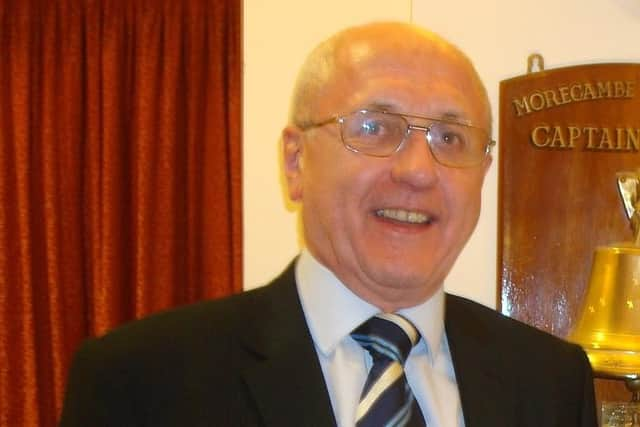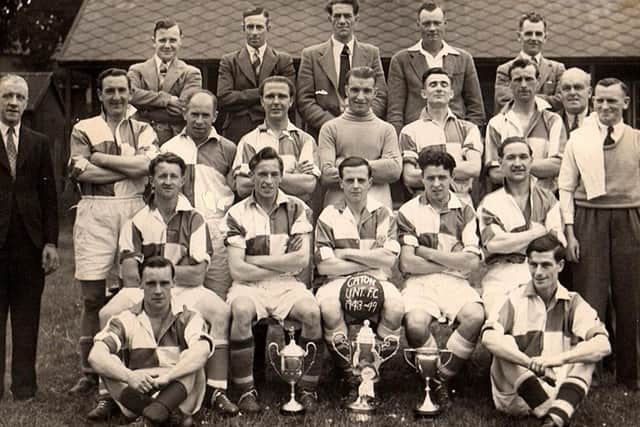Lancaster football historian reflects on the sad demise of North Lancashire and District Football League
and live on Freeview channel 276
“The Lancaster & District League was first formed in 1891-92 and had various names from then until 1919-20 when it became the North Lancashire & District Football League and that name has remained in place until the present day.
"Prior to the league being formed a number of teams played in the Lancaster area, up to 30 teams, and from the archives of the Lancaster Guardian I can name some of them as follows: Skerton St Lukes, Lancaster Wesleyans, Scorton, Pilling St John’s, Galgate, Scotforth Villa, Bowerham Rovers, Storey Brothers, Marsh Hornets, Williamson’s Employees, Gorrill’s Employees. Many of these clubs had two teams and some like Skerton St Lukes and Skerton Wesleyan Swifts had three.
Advertisement
Hide AdAdvertisement
Hide Ad“Football in those far-off days was when players changed in the lee of a sheltering hedge or wall, dressing rooms were not even imagined and showers limited to the kind that fell freely from the skies. In season 1900-01 the Lancaster & District League comprised of eight clubs but these numbers painted a false picture of how popular football was in the Lancaster area. In December 1900 almost 40 teams turned out to test their footballing prowess. It was fairly obvious that in the early days of official league tables, they were simply the tip of the iceberg as a measurement of the extent of football in the Lancaster district.


“By 1911-12 the league was known as the North Lancashire & District League that was played alongside the Lancaster & District Church League. By 1919-20 the North Lancashire & District Football League, nine teams, was won by Lancaster Discharged and the Second Division, 16 teams, by Ward’s Employees. By 1924-25 there were three divisions comprising 37 teams. In 1938-39 Division 1, 13 teams, was won by Milnthorpe Corinthians, Division 2 Section “A”, 11 teams, was won by Carnforth Rangers, Division 2 Section “B”, 11 teams, was won by Halton Lads and the Juvenile Section, eight teams, was won by Dallam Rangers.
“During the war years, 1944-45, the Senior Division, 12 teams, was won by 38 Recce Regiment, runners-up were the Royal Air Force who included both Raich Carter and Peter Doherty who played for Derby County in season 1945-46. Peter Doherty played for the Royal Air Force during World War II in the North Lancs League with Raich Carter playing for the 38 Recce Regiment during the same period. When you look at the league table for season 1944-45 it seems that these two great players certainly had an influence on local football with the 38 Reece Regiment having a 100% record, outstanding at any level of the game. In the same year the Junior Division, 10 teams, was won by St Paul’s Juniors. I believe the Royal Air Force played their games at Christie Park while the 38 Recce Regiment played on Springfield Park, Lancaster.
“I was born in 1942 in Caton so the team I supported was Caton United from the age of about five in 1947.Luckily my mother loved football so we followed the team home and away who played in white shirts and black shorts, a wonderful strip. By 1948-49, Division 1, 14 teams, was won by Caton United, Division 2 Section “A”, 14 teams, was won by Ingleborough, Division 2 Section “B”, 13 teams, was won by Heysham Reserves, Junior League Division 1 (under 18’s), nine teams, was won by Freehold United, Junior League Division 2 (under 16s), 10 teams, was won by Red Rose Boys Club Juniors. Some 60 teams in total, at a conservative estimate, that would involve over 800 players plus officials so the number of people involved in football was well over 1,000. At Caton there were about 10 men on the committee plus their wives and girlfriends who raised money by holding whist and domino drives. The whole village seemed to revolve around the football and cricket clubs – it was a magical time.
Advertisement
Hide AdAdvertisement
Hide Ad“The outstanding club at the time was Bentham United – derby games against Caton would attract over 1,000 fans at Caton and a similar number at Bentham. Power in local football shifted quite dramatically after the 1949-50 season from Caton, Galgate and Bolton-le-Sands to Ingleborough and Bentham. Let’s look at the Caton United team that were Champions of Division 1 and winners of the Parkinson Cup and Senior Challenge Cup. The photograph used with this article was taken on Jowett’s Field in 1948-49 which was across the main railway line down the road opposite to the Station Hotel, Caton.


Back row L-R – Dick Woolcock, George Wilson, Stanley Walker, Bill Dainty, George Robinson.
2nd row L-R – Tom Eglin, Bill Hodgson, Jimmy Till, Jimmy Clarkson, Bert Cartmel, Albert Robinson, Jack Bowker, Ritson Stockdale, Sid Southward.
1st row L-R – Fred Robinson, Joe Easterby, Jock Kerr, Ted Fairclough, Cyril Gardner.
Sat on the grass – Jimmy Mason, Frank Woodhouse.
Advertisement
Hide AdAdvertisement
Hide AdEight committee members on the photograph – Bill Hodgson had trials with Blackpool, Albert Robinson played in the Third Division South, a marvellous left-wing player, Joe Easterby was chased by Wolverhampton Wanderers whose manager met him in the Midland Hotel, Morecambe, offered him top money of £10 per week but Joe said I’m not interested, I’ve been away in the war and I’ll never leave home again, also I earn £6 a week at Claughton Brickworks and £4 a week from Morecambe so the money offered by Wolves was no temptation at all and sadly Bert Cartmel, an excellent goalkeeper, who left Caton only to collapse on the field and die a year or two later.
"The demise of the North Lancashire and District Football League is a terrible loss to players like me whose whole life focused on football every Saturday, training Tuesday and Thursday, and I remember people who gave their life to it, like Jimmy Brown at Dry Dock United, John Bagot, secretary of the League for many years, Sam Price, Jimmy Downham at the Lancaster Lads Club, Wilson Huck at the Red Rose Boys Club on St George’s Quay, John Garnett at Milnthorpe Corinthians and many others at clubs too numerous to mention.
“A very sad day for me and a host of friends who literally played many sports but football was the backbone of our lives.”